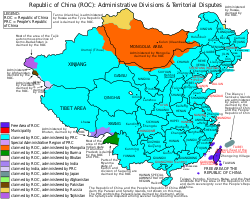TAIWAN MAP
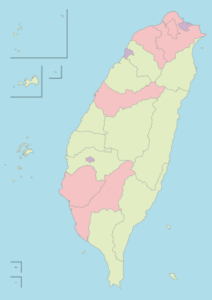
TAIWAN MAP
TAIWAN MAP, Roughly 84 per cent of Taiwan’s population are descendants of Han Chinese immigrants from Qing China between 1683 and 1895. Another significant fraction descends from Han Chinese who immigrated from mainland China in the late 1940s and early 1950s. The shared cultural origin combined with several hundred years of geographical separation, some hundred years of political separation and foreign influences….READ MORE
Administrative divisions

Map comparing political divisions as drawn by the Republic of China and the People’s Republic of China. |
According to the 1947 constitution, the territory of the ROC is according to its “existing national boundaries”.[355] The ROC is, de jure constitutionally, divided into provinces, special municipalities (which are further divided into districts for local administration), and the province-level Tibet Area. Each province is subdivided into cities and counties, which are further divided into townships and county-administered cities, each having elected mayors and city councillors who share duties with the county. Some divisions are indigenous divisions which have different degrees of autonomy to standard ones. In addition, districts, cities and townships are further divided into villages and neighbourhoods. The provinces have been “streamlined” and are no longer functional.[356] Similarly, banners in both Mongolia and mainland China (Inner Mongolia) also existed, but they were abolished in 2006 and the ROC reaffirmed its recognition of Mongolia in 2002, as stipulated in the 1946 constitution.[357][358][339]
With provinces non-functional, Taiwan is, in practice, divided into 22 subnational divisions, each with a self-governing body led by an elected leader and a legislative body with elected members. Duties of local governments include social services, education, urban planning, public construction, water management, environmental protection, transport, public safety, and more.
When the ROC retreated to Taiwan in 1949, its claimed territory consisted of 35 provinces, 12 special municipalities, 1 special administrative region and 2 autonomous regions. However, since its retreat, the ROC has controlled only Taiwan Province and some islands of Fujian Province. The ROC also controls the Pratas Islands and Taiping Island in the Spratly Islands, which are part of the disputed South China Sea Islands. They were placed under Kaohsiung administration after the retreat to Taiwan.[359]
- Notes
- ^ Jump up to:a b c d e f Has an elected executive and an elected legislative council.
- ^ Jump up to:a b c Has an appointed district administrator for managing local affairs and carrying out tasks commissioned by superior agency.
- ^ Has an elected village administrator for managing local affairs and carrying out tasks commissioned by superior agency.
Military
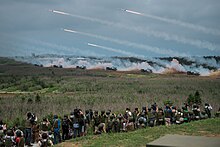
Han Kuang Exercise is the annual exercise of the ROC Armed Forces for a possible attack from the PRC
The Republic of China Army takes its roots in the National Revolutionary Army, which was established by Sun Yat-sen in 1925 in Guangdong with a goal of reunifying China under the Kuomintang. When the People’s Liberation Army won the Chinese Civil War, much of the National Revolutionary Army retreated to Taiwan along with the government. It was later reformed into the Republic of China Army. Units which surrendered and remained in mainland China were either disbanded or incorporated into the People’s Liberation Army.
From 1949 to the 1970s, the primary mission of the Taiwanese military was to “retake mainland China” through Project National Glory. As this mission has transitioned away from attack because the relative strength of the PRC has massively increased, the ROC military has begun to shift emphasis from the traditionally dominant Army to the air force and navy. Control of the armed forces has also passed into the hands of the civilian government.[360][361]
The ROC began a series of force reduction plans since 1990s, Jingshi An (translated to streamlining program) was one of the programs to scale down its military from a level of 450,000 in 1997 to 380,000 in 2001.[362] As of 2021, the total strength of the Armed Forces is capped at 215,000 with 90 percent manning ratio for volunteer military.[363] Conscription remains universal for qualified males reaching age eighteen, but as a part of the reduction effort many are given the opportunity to fulfill their draft requirement through alternative service and are redirected to government agencies or arms related industries.[364] Taiwan cut compulsory military service to four months in 2013 but will extend military service to one year in 2024.[365][366] The military’s reservists is around 2.5 million including first-wave reservists numbered at 300,000 as of 2022.[367] Taiwan’s defense spending as a percentage of its GDP fell below three percent in 1999 and had been trending downwards over the first two decades of the twenty-first century.[368][369] The ROC government spent approximately two percent of GDP on defense and failed to raise the spending as high as proposed three percent of GDP.[370][371][372] In 2022, Taiwan proposed 2.4 percent of projected GDP in defense spending for the following year, continued to remain below three percent.[373]
The ROC and the United States signed the Sino-American Mutual Defense Treaty in 1954, and established the United States Taiwan Defense Command. About 30,000 US troops were stationed in Taiwan, until the United States established diplomatic relations with the PRC in 1979.[374] A significant amount of military hardware has been bought from the United States, and continues to be legally guaranteed by the Taiwan Relations Act.[291] In the past, France and the Netherlands have also sold military weapons and hardware to the ROC, but they almost entirely stopped in the 1990s under pressure of the PRC.[375][376]
There is no guarantee in the Taiwan Relations Act or any other treaty that the United States will defend Taiwan, even in the event of invasion.[377] On several occasions in 2021 and 2022, U.S. President Joe Biden stated that the United States will intervene if the PRC attempts to invade Taiwan.[378][379][380][381] However, when asked about the answer, the White House officials insisted that US policy on Taiwan has not changed.[382][383] The joint declaration on security between the US and Japan signed in 1996 may imply that Japan would be involved in any response. However, Japan has refused to stipulate whether the “area surrounding Japan” mentioned in the pact includes Taiwan, and the precise purpose of the pact is unclear.[384] The Australia, New Zealand, United States Security Treaty (ANZUS Treaty) may mean that other US allies, such as Australia, could theoretically be involved.[385][386] While this would risk damaging economic ties with China,[387] a conflict over Taiwan could lead to an economic blockade of China by a greater coalition.[388][389][390][391][392]
Economy
Economic history
The quick industrialization and rapid growth of Taiwan during the latter half of the 20th century has been called the “Taiwan Miracle”. Taiwan is one of the “Four Asian Tigers” alongside Hong Kong, South Korea and Singapore.
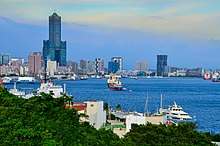
Port of Kaohsiung is operated as the largest harbor in Taiwan
Japanese rule prior to and during World War II brought changes in the public and private sectors, most notably in the area of public works, which enabled rapid communications and facilitated transport throughout much of the island. The Japanese also improved public education and made it compulsory for all residents of Taiwan. By 1945, hyperinflation was in progress in mainland China and Taiwan as a result of the war with Japan. To isolate Taiwan from it, the Nationalist government created a new currency area for the island, and began a price stabilization program which helped to significantly slow inflation.
When the KMT government fled to Taiwan it brought millions of taels (where 1 tael = 37.5 g or ~1.2 ozt) of gold and the foreign currency reserve of mainland China, which, according to the KMT, stabilized prices and reduced hyperinflation.[393] Perhaps more importantly, as part of its retreat to Taiwan, the KMT brought the intellectual and business elites from mainland China.[394] The KMT government instituted many laws and land reforms that it had never effectively enacted on mainland China. The government also implemented a policy of import-substitution, attempting to produce imported goods domestically.[395]
In 1950, with the outbreak of the Korean War, the United States began an aid programme which resulted in fully stabilized prices by 1952.[396] Economic development was encouraged by American economic aid and programmes such as the Joint Commission on Rural Reconstruction, which turned the agricultural sector into the basis for later growth. Under the combined stimulus of the land reform and the agricultural development programmes, agricultural production increased at an average annual rate of 4 per cent from 1952 to 1959, which was greater than the population growth, 3.6 per cent.[397]
In 1962, Taiwan had a (nominal) per-capita gross national product (GNP) of $170, placing its economy on a par with those of the Democratic Republic of the Congo. On a purchasing power parity (PPP) basis, its GDP per capita in the early 1960s was $1,353 (in 1990 prices). By 2011 per-capita GNP, adjusted for purchasing power parity (PPP), had risen to $37,000, contributing to a Human Development Index (HDI) equivalent to that of other developed countries. In 2021, the HDI calculated by Taiwan’s Statistic Bureau was the fifth-highest in the Asia-Pacific region.[25]
In 1974, Chiang Ching-Kuo implemented the Ten Major Construction Projects, the transportation, energy, and basic industry infrastructure that helped Taiwan transform into its current export driven economy. Since the 1990s, a number of Taiwan-based technology firms have expanded their reach around the world. Well-known international technology companies headquartered in Taiwan include personal computer manufacturers Acer Inc. and Asus, mobile phone maker HTC, as well as electronics manufacturing giant Foxconn, which makes products for Apple, Amazon, and Microsoft.[398] Computex is a major computer convention, held annually in Taipei since 1981, and is attended by major tech companies like AMD and Nvidia.[399]

Taipei 101 held the world record for the highest skyscraper from 2004 to 2010.
In 2001, agriculture constituted only 2 per cent of GDP, down from 35 per cent in 1952.[400] Traditional labour-intensive industries are steadily being moved offshore and with more capital and technology-intensive industries replacing them. High-technology industrial parks have sprung up in every region in Taiwan. The ROC has become a major foreign investor in the PRC, Thailand, Indonesia, the Philippines, Malaysia, and Vietnam. It is estimated that some 50,000 Taiwanese businesses and 1,000,000 businesspeople and their dependents are established in the PRC.[401]
Since the beginning of the 1990s, the economic ties between Taiwan and the People’s Republic of China have been extensive. As of 2008, more than US$150 billion[402] have been invested in the PRC by Taiwanese companies. Although the economy of Taiwan benefits from this situation, some have expressed the view that the island has become increasingly dependent on the mainland Chinese economy. A 2008 white paper by the Department of Industrial Technology states that “Taiwan should seek to maintain stable relation with China while continuing to protect national security, and avoiding excessive ‘Sinicization’ of Taiwanese economy.”[403] Others argue that close economic ties between Taiwan and mainland China would make any military intervention by the PLA against Taiwan very costly, and therefore less probable.[404]
Today Taiwan has a dynamic, capitalist, export-driven economy with gradually decreasing state involvement in investment and foreign trade. In keeping with this trend, some large government-owned banks and industrial firms are being privatized.[405] Real growth in GDP has averaged about 8 per cent during the past three decades. Exports have provided the primary impetus for industrialization. The trade surplus is substantial, and foreign reserves are the world’s fifth largest.[406] The official currency of Taiwan by the ROC is the New Taiwan dollar. Taiwan’s total trade in 2010 reached an all-time high of US$526.04 billion, according to Taiwan’s Ministry of Finance. Both exports and imports for the year reached record levels, totaling US$274.64 billion and US$251.4 billion, respectively.[407]
Because of its conservative financial approach and its entrepreneurial strengths, Taiwan suffered little compared with many of its neighbours in the 1997 Asian financial crisis. Unlike its neighbours, South Korea and Japan, the Taiwanese economy is dominated by small and medium-sized businesses, rather than the large business groups. The global economic downturn, however, combined with poor policy co-ordination by the new administration and increasing bad debts in the banking system, pushed Taiwan into recession in 2001, the first whole year of negative growth since 1947. Due to the relocation of many manufacturing and labour-intensive industries to the PRC, unemployment also reached a level not seen since the 1970s oil crisis. This became a major issue in the 2004 presidential election. Growth averaged more than 4 per cent in the 2002–2006 period and the unemployment rate fell below 4 per cent.[408]
High-tech manufacturing

TSMC fab 5 located in Hsinchu Science Park
Taiwan is a key player in the supply chain for advanced chips.[409] Taiwan’s rise in the key semiconductor industry was largely attributed to Taiwan Semiconductor Manufacturing Co. (TSMC) and United Microelectronic Corporation (UMC).[410] TSMC was founded 21 February 1987 and as of December 2021 its market capitalization equated to roughly 90% of Taiwan’s GDP.[411] The company is the 9th largest in the world by market capitalization[412] as well as the world’s biggest semiconductor manufacturing company, surpassing Intel and Samsung.[413] Its major customers include Qualcomm, Nvidia, Broadcom, Intel, AMD, Apple Inc., Ampere, Microsoft, MediaTek and Sony.[414] In 2018, the company’s N7+ node became the first commercial node to be made with EUV lithography, as well its N7 node being the first sub-10 nm node to enter volume production.[415][416] TSMC was the first Taiwanese company to be listed on the New York Stock Exchange, under the trade name NYSE: TSM, in October 1997.[417]
UMC, another major company in Taiwan’s high-tech exports and global semiconductors, does not however, compete with TSMC on advance semiconductor processes. Instead it competes with the American GlobalFoundries, and others, for less advanced semiconductor processes and for silicon wafers.[418] Its major customers include, MediaTek, Texas Instruments, and Realtek.[419]
Foxconn, a major smart-device manufacturer, is headquartered in New Taipei City.[420] It is also listed in the Taiwan Stock Exchange under the trade name Hon Hai Precision Industry.[421] Most of its factories are located in East Asia, with a majority of 12 factories located in China.[422][423] Its major customers include Apple, Microsoft, Amazon, Google, and Huawei.[398]
Transport

China Airlines aircraft line-up at Taoyuan International Airport
The Ministry of Transportation and Communications of the Republic of China is the cabinet-level governing body of the transport network in Taiwan.
Civilian transport in Taiwan is characterised by extensive use of scooters. In March 2019, 13.86 million were registered, twice that of cars.[424]
Both highways and railways are concentrated near the coasts, where the majority of the population resides, with 1,619 km (1,006 mi) of motorway.
Railways in Taiwan are primarily used for passenger services, with Taiwan Railway Administration (TRA) operating a circular route and Taiwan High Speed Rail (THSR) running high speed services on the west coast. Urban transit systems include Taipei Metro, Kaohsiung Metro, Taoyuan Metro, New Taipei Metro, and Taichung Metro.
Major airports include Taiwan Taoyuan, Kaohsiung, Taipei Songshan and Taichung. There are currently seven airlines in Taiwan, with the largest two being China Airlines and EVA Air.
There are seven international seaports: Keelung, Taipei, Suao, Taichung, Kaohsiung, Anping, and Hualien.[425] The Port of Kaohsiung handled the largest volume of cargo in Taiwan, with about 440 million shipping tonnes, which accounted for 58.6% of Taiwan’s total throughput in 2021.[426] The shipping tonnage followed by Taichung (18.6%), Taipei (12%) and Keelung (8.7%).
Education

Gate of National Taiwan University, the university was founded in 1928 during Japanese rule
Taiwan’s higher education system was established by Japan during the colonial period. However, after the Republic of China took over in 1945, the system was promptly replaced by the same system as in mainland China which mixed features of the Chinese and American educational systems.[427]
Taiwan is well known for adhering to the Confucian paradigm of valuing education as a means to improve one’s socioeconomic position in society.[428][429] Heavy investment and a cultural valuing of education has catapulted the resource-poor nation consistently to the top of global education rankings. Taiwan is one of the top-performing countries in reading literacy, mathematics and sciences. In 2015, Taiwanese students achieved one of the world’s best results in mathematics, science and literacy, as tested by the Programme for International Student Assessment (PISA), with the average student scoring 519, compared with the OECD average of 493, placing it seventh in the world.[430][431][432]
The Taiwanese education system has been praised for various reasons, including its comparatively high test results and its major role in promoting Taiwan’s economic development while creating one of the world’s most highly educated workforces.[433][434] Taiwan has also been praised for its high university entrance rate where the university acceptance rate has increased from around 20 per cent before the 1980s to 49 per cent in 1996 and over 95 per cent since 2008, among the highest in Asia.[435][436][437] The nation’s high university entrance rate has created a highly skilled workforce making Taiwan one of the most highly educated countries in the world with 68.5 per cent of Taiwanese high school students going on to attend university.[438] Taiwan has a high percentage of its citizens holding a tertiary education degree where 45 per cent of Taiwanese aged 25–64 hold a bachelor’s degree or higher compared with the average of 33 per cent among member countries of the Organisation for Economic Cooperation and Development (OECD).[437][439]
On the other hand, the system has been criticised for placing excessive pressure on students while eschewing creativity and producing an excess supply of over-educated university graduates and a high graduate unemployment rate. With a large number of university graduates seeking a limited number of prestigious white collar jobs in an economic environment that is increasingly losing its competitive edge, this has led many graduates to be employed in lower-end jobs with salaries far beneath their expectations.[440][429] Taiwan’s universities have also been under criticism for not being able to fully meet the requirements and demands of Taiwan’s 21st-century fast-moving labour market, citing a skills mismatch among a large number of self-assessed, overeducated university graduates who do not fit the demands of the modern Taiwanese labour market.[441] The Taiwanese government has also received criticism for undermining the economy as it has been unable to produce enough jobs to meet the demands of numerous underemployed university graduates.[435][442]
As the Taiwanese economy is largely science and technology based, the labour market demands people who have achieved some form of higher education, particularly related to science and engineering to gain a competitive edge when searching for employment. Although current Taiwanese law mandates only nine years of schooling, 95 per cent of junior high graduates go on to attend a senior vocational high school, university, junior college, trade school, or other higher education institution.[438][443]
Since Made in China 2025 was announced in 2015, aggressive campaigns to recruit Taiwanese chip industry talent to support its mandates resulted in the loss of more than 3,000 chip engineers to mainland China,[444] and raised concerns of a “brain drain” in Taiwan.[445][444][446]
Many Taiwanese students attend cram schools, or buxiban, to improve skills and knowledge on problem solving against exams of subjects like mathematics, nature science, history and many others. Courses are available for most popular subjects and include lectures, reviews, private tutorial sessions, and recitations.[447][448]
As of 2020, the literacy rate in Taiwan was 99.03 percent.[449]
Demographics
Taiwan has a population of about 23.4 million,[450] most of whom are on the island of Taiwan. The remainder live on the outlying islands of Penghu (101,758), Kinmen (127,723), and Matsu (12,506).[451]
Largest cities and counties
The figures below are the March 2019 estimates for the twenty most populous administrative divisions; a different ranking exists when considering the total metropolitan area populations (in such rankings the Taipei-Keelung metro area is by far the largest agglomeration). The figures reflect the number of household registrations in each city, which may differ from the number of actual residents.
|
||||||||||||||||||||||||||||||||||||||||||||||||||||||||||
Ethnic groups
The ROC government reports that over 95 per cent of the population is Han. The overwhelming majority of them (85 per cent) are descendants of Hoklo and Hakka who arrived in large numbers in the 17th to 18th century. A minority (10 to 15 per cent) are waishengren, descendants of Chinese nationalists who fled to Taiwan the end of the Chinese Civil War in 1949. There are also 2 per cent indigenous Austronesian peoples and 2 per cent new immigrants primarily from China and Southeast Asia.[109][14]
The Hoklo people are the largest ethnic group (70 per cent of the total population), whose ancestors migrated from the coastal southern Fujian region across the Taiwan Strait starting in the 17th century. The Hakka comprise about 15 per cent of the total population, and descend from Han migrants from eastern Guangdong.[452] Genetic studies also indicate that the Hoklo and Hakka people that make up majority of the Taiwanese population, are a mixture between Austronesians and Han people.[453]
The indigenous Taiwanese aborigines number about 533,600, and the government recognises 16 groups.[454] The Ami, Atayal, Bunun, Kanakanavu, Kavalan, Paiwan, Puyuma, Rukai, Saisiyat, Saaroa, Sakizaya, Sediq, Thao, Truku and Tsou live mostly in the eastern half of the island, while the Yami inhabit Orchid Island.[455][456]
Languages

TAIWAN MAP
Most commonly used home language in each area, darker in proportion to the lead over the next most common
Mandarin is the primary language used in business and education, and is spoken by the vast majority of the population. Traditional Chinese is used as the writing system.[457] The Republic of China does not have any legally designated official language, but Mandarin plays the role of the de facto official language.[3]
Around 70% of Taiwan’s population belong to the Hoklo ethnic group and are speakers of Taiwanese Hokkien as native language.[458] The Hakka group, comprising some 14–18 per cent of the population, speak Hakka. Although Mandarin is the language of instruction in schools and dominates television and radio, non-Mandarin Chinese varieties have undergone a revival in public life in Taiwan, particularly since restrictions on their use were lifted in the 1990s.[457]
Formosan languages are spoken primarily by the indigenous peoples of Taiwan. They do not belong to the Chinese or Sino-Tibetan language family, but to the Austronesian language family, and are written in Latin alphabet.[459] Their use among aboriginal minority groups has been in decline as usage of Mandarin has risen.[457] Of the 14 extant languages, five are considered moribund.[460]
Classical Chinese
Since the May Fourth Movement, written vernacular Chinese had replaced Classical Chinese and emerged as the mainstream written Chinese in the Republic of China. But Classical Chinese continued to be widely used in the Government of the Republic of China. Most government documents in the Republic of China were written in Classical Chinese until reforms in the 1970s, in a reform movement spearheaded by President Yen Chia-kan to shift the written style to a more integrated vernacular Chinese and Classical Chinese style (文白合一行文).[461][462] After 1 January 2005, the Executive Yuan also changed the long-standing official document writing habit from vertical writing style to horizontal writing style.
Today, pure Classical Chinese is occasionally used in formal or ceremonial occasions, religious or cultural rites in Taiwan. The National Anthem of the Republic of China (中華民國國歌), for example, is in Classical Chinese. Taoist texts are still preserved in Classical Chinese from the time they were composed. Buddhist texts, or sutras, are still preserved in Classical Chinese from the time they were composed or translated from Sanskrit sources. In practice there is a socially accepted continuum between vernacular Chinese and Classical Chinese. Most official government documents, legal, courts rulings and judiciary documents use a combined vernacular Chinese and Classical Chinese style (文白合一行文).[463] For example, most official notices and formal letters are written with a number of stock Classical Chinese expressions (e.g. salutation, closing). Personal letters, on the other hand, are mostly written in vernacular, but with some Classical phrases, depending on the subject matter, the writer’s level of education, etc.
As many legal documents are still written in Classical Chinese, which is not easily understood by the general public, a group of Taiwanese had launched the Legal Vernacular Movement hoping to bring more Vernacular Chinese into the legal writings of the Republic of China.[464]
Taiwan is officially multilingual. A national language in Taiwan is legally defined as “a natural language used by an original people group of Taiwan and the Taiwan Sign Language“.[11] As of 2019, policies on national languages are in early stages of implementation, with Hakka and indigenous languages designated as such.
Religion

Wanhe Temple is one of the temples dedicated to the sea goddess Mazu
The Constitution of the Republic of China protects people’s freedom of religion and the practices of belief.[465] Freedom of religion in Taiwan is strong and ranks high at 9.2 in 2018 according to World Bank.[466]
In 2005, the census reported that the five largest religions were: Buddhism, Taoism, Yiguandao, Protestantism, and Roman Catholicism.[467] According to Pew Research, the religious composition of Taiwan in 2020[468] is estimated to be 43.8 per cent Folk religions, 21.2 per cent Buddhist, 15.5 Others (including Taoism), 13.7 per cent Unaffiliated, 5.8 per cent Christian and 1% Muslim. Taiwanese aborigines comprise a notable subgroup among professing Christians: “… over 64 per cent identify as Christian … Church buildings are the most obvious markers of Aboriginal villages, distinguishing them from Taiwanese or Hakka villages”.[469] There has been a small Muslim community of Hui people in Taiwan since the 17th century.[470]
Confucianism is a philosophy that deals with secular moral ethics, and serves as the foundation of both Chinese and Taiwanese culture. The majority of Taiwanese people usually combine the secular moral teachings of Confucianism with whatever religions they are affiliated with.
As of 2019, there were 15,175 religious buildings in Taiwan, approximately one place of worship per 1,572 residents. 12,279 temples were dedicated to Taoism and Buddhism. There were 9,684 Taoist Temples and 2,317 Buddhist Temples.[471] In Taiwan’s 36,000 square kilometers of land, there are more than 33,000 places for religious (believers) to worship and gather. On average, there is one temple or church (church) or religious building for every square kilometer. The high density of place of worship is rare in the world, and it is the area with the highest density of religious buildings in the Chinese-speaking world. Taiwan is also the most religious region in the Chinese-speaking world. Even for Christianity, there are 2,845 Churches.[471]
A significant percentage of the population of Taiwan is non-religious. Taiwan’s strong human rights protections, lack of state-sanctioned discrimination, and generally high regard for freedom of religion or belief earned it a joint #1 ranking in the 2018 Freedom of Thought Report, alongside the Netherlands and Belgium.[472]
Taiwan is clearly an outlier in the top 3, all-clear countries. It is non-European, and demographically much more religious. But in its relatively open, democratic and tolerant society we have recorded no evidence of laws or social discrimination against members of the non-religious minority.[473]
LGBT rights
On 24 May 2017, the Constitutional Court ruled that then-current marriage laws had been violating the Constitution by denying Taiwanese same-sex couples the right to marry. The Court ruled that if the Legislative Yuan did not pass adequate amendments to Taiwanese marriage laws within two years, same-sex marriages would automatically become lawful in Taiwan.[474] In a referendum question in 2018, however, voters expressed overwhelming opposition to same-sex marriage and supported the removal of content about homosexuality from primary school textbooks. According to the New York Times, the aforementioned referendum questions were subject to a “well-funded and highly organized campaign led by conservative Christians and other groups” involving the use of “misinformation, the bulk of which was spread online.”[314] Nevertheless, the vote against same-sex marriage does not affect the court ruling, and on 17 May 2019, Taiwan’s parliament approved a bill legalising same-sex marriage, making it the first country in Asia to do so.[475][476][477]
Taiwan has an annual pride event, Taiwan Pride. It currently holds the record for the largest LGBT gathering in East-Asia, rivaling Tel Aviv Pride in Israel.[478] The event draws more than 200,000 people to demonstrate for equal rights for LGBT people.[479] The event is organized by the Taiwan LGBT Pride Community, and is held on the last Sunday of October.[480]
Health
The current healthcare system in Taiwan, known as National Health Insurance (NHI, Chinese: 全民健康保險), was instituted in 1995. NHI is a single-payer compulsory social insurance plan that centralizes the disbursement of healthcare funds. The system promises equal access to healthcare for all citizens, and the population coverage had reached 99 per cent by the end of 2004.[481] NHI is mainly financed through premiums, which are based on the payroll tax, and is supplemented with out-of-pocket co-payments and direct government funding.[482][483][484] Low-income families, veterans, centenarians, children under three years old, and catastrophic diseases are exempt from co-payments. Co-pays are reduced for disabled and low income households maintain 100 percent premium coverage by the NHI.
Early in the program, the payment system was predominantly fee-for-service. Most health providers operate in the private sector and form a competitive market on the health delivery side. However, many healthcare providers took advantage of the system by offering unnecessary services to a larger number of patients and then billing the government. In the face of increasing loss and the need for cost containment, NHI changed the payment system from fee-for-service to a global budget, a kind of prospective payment system, in 2002.
The implementation of universal healthcare created fewer health disparities for lower-income citizens in Taiwan. According to a recently published survey, out of 3,360 patients surveyed at a randomly chosen hospital, 75.1 per cent of the patients said they are “very satisfied” with the hospital service; 20.5 per cent said they are “okay” with the service. Only 4.4 per cent of the patients said they are either “not satisfied” or “very not satisfied” with the service or care provided.[485]
The Taiwanese disease control authority is the Taiwan Centers for Disease Control (CDC), and during the SARS outbreak in March 2003 there were 347 confirmed cases. During the outbreak the CDC and local governments set up monitoring stations throughout public transportation, recreational sites and other public areas. With full containment in July 2003, there has not been a case of SARS since.[486] Owing to the lessons from SARS, a National Health Command Center was established in 2004, which includes the Central Epidemic Command Center (CECC). The CECC has since played a central role in Taiwan’s approach to epidemics, including the COVID-19 pandemic.
In 2019, the infant mortality rate was 4.2 deaths per 1,000 live births, with 20 physicians and 71 hospital beds per 10,000 people.[487][488] Life expectancy at birth in 2020 is 77.5 years and 83.9 years for males and females, respectively.[489]
Culture
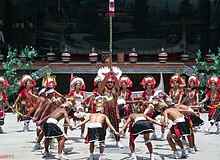
Amis people of Taiwan performing a traditional dance
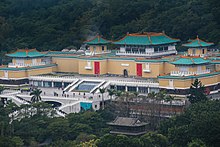
The National Palace Museum is an institute dedicated to the organization, care, and display of ancient Chinese artifacts and works of art
The cultures of Taiwan are a hybrid blend from various sources, incorporating elements of the majority traditional Chinese culture, aboriginal cultures, Japanese cultural influence, traditional Confucianist beliefs, and increasingly, Western values.
During the martial law period in which the Republic of China was officially anti-communist, the Kuomintang promoted an official traditional Chinese culture over Taiwan in order to emphasize that the Republic of China represents the true orthodoxy to Chinese Culture (and therefore the “real and legitimate China”) as opposed to Communist China.[490] The government launched what’s known as the Chinese Cultural Renaissance movement in Taiwan in opposition to the cultural destructions caused by the Chinese Communist Party during the Cultural Revolution. The General Assembly of Chinese Culture (中華文化總會) was established as a movement promotion council to help promote Chinese Culture in Taiwan and overseas. It was Kuomintang‘s first structured plan for cultural development on Taiwan. Chiang himself was the head of the General Assembly of Chinese Culture. Subsequent President of the Republic of China also became the head of this General Assembly. The Chinese Cultural Renaissance movement in Taiwan had led to some aspects of Chinese Culture being better preserved there than in mainland China. An example of this preservation is the continued use of Traditional Chinese. The influence of Confucianism can be found in the behaviour of Taiwanese people, known for their friendliness and politeness.[491]
The lifting of martial law ushered a period of democratization whereby Freedom of Speech and Expression led to a flourishing Taiwanese literature and Mass media in Taiwan.
Reflecting the continuing controversy surrounding the political status of Taiwan, politics continues to play a role in the conception and development of a Taiwanese cultural identity, especially in its relationship to Chinese culture.[492] In recent years, the concept of Taiwanese multiculturalism has been proposed as a relatively apolitical alternative view, which has allowed for the inclusion of mainlanders and other minority groups into the continuing re-definition of Taiwanese culture as collectively held systems of meaning and customary patterns of thought and behaviour shared by the people of Taiwan.[493] Identity politics, along with the over one hundred years of political separation from mainland China, has led to distinct traditions in many areas, including cuisine and music.

